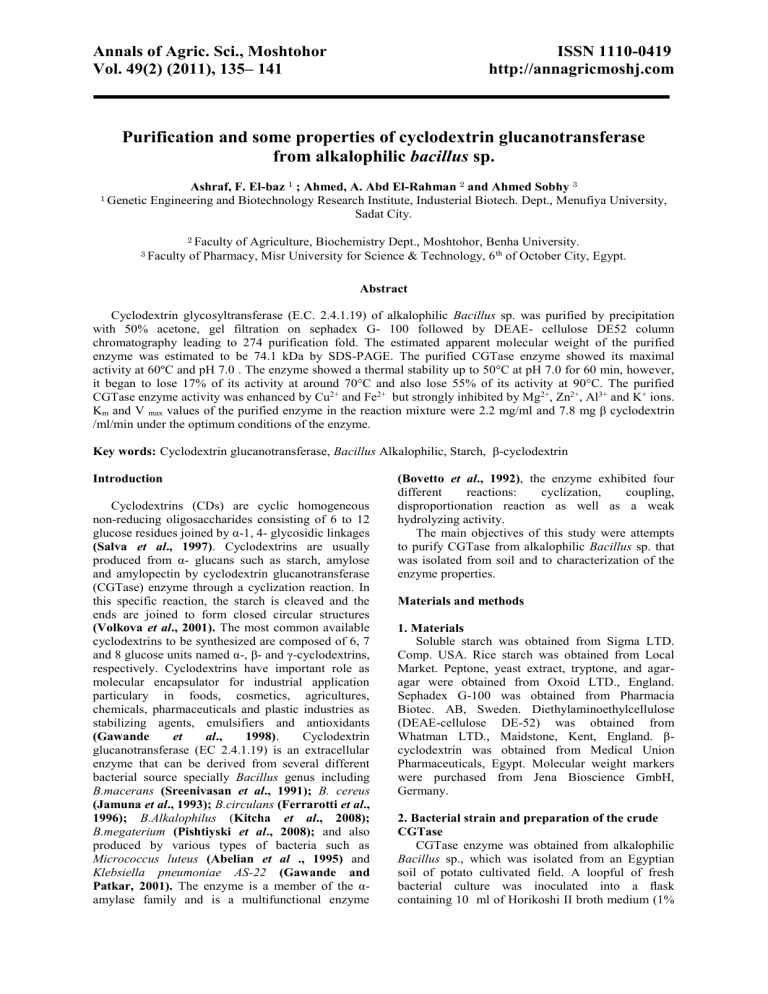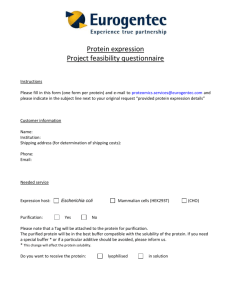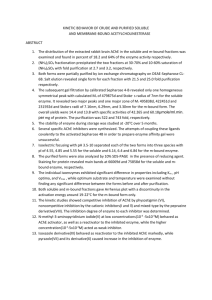Ahmed Ali Ahmed Abd El

Annals of Agric. Sci., Moshtohor ISSN 1110-0419
Vol. 49(2) (2011), 135– 141 http://annagricmoshj.com
Purification and some properties of cyclodextrin glucanotransferase from alkalophilic bacillus sp.
Ashraf, F. El-baz
1
; Ahmed, A. Abd El-Rahman
2
and Ahmed Sobhy
3
1
Genetic Engineering and Biotechnology Research Institute, Industerial Biotech. Dept., Menufiya University,
Sadat City.
2
Faculty of Agriculture, Biochemistry Dept., Moshtohor, Benha University.
3
Faculty of Pharmacy, Misr University for Science & Technology, 6 th of October City, Egypt.
Abstract
Cyclodextrin glycosyltransferase (E.C. 2.4.1.19) of alkalophilic Bacillus sp. was purified by precipitation with 50% acetone, gel filtration on sephadex G- 100 followed by DEAE- cellulose DE52 column chromatography leading to 274 purification fold. The estimated apparent molecular weight of the purified enzyme was estimated to be 74.1 kDa by SDS-PAGE. The purified CGTase enzyme showed its maximal activity at 60ºC and pH 7.0 . The enzyme showed a thermal stability up to 50°C at pH 7.0 for 60 min, however, it began to lose 17% of its activity at around 70°C and also lose 55% of its activity at 90°C. The purified
CGTase enzyme activity was enhanced by Cu 2+ and Fe 2+ but strongly inhibited by Mg 2+ , Zn 2+ , Al 3+ and K + ions.
K m
and V max
values of the purified enzyme in the reaction mixture were 2.2 mg/ml and 7.8 mg β cyclodextrin
/ml/min under the optimum conditions of the enzyme.
Key words: Cyclodextrin glucanotransferase, Bacillus Alkalophilic, Starch, β-cyclodextrin
Introduction
Cyclodextrins (CDs) are cyclic homogeneous non-reducing oligosaccharides consisting of 6 to 12 glucose residues joined by α-1, 4- glycosidic linkages
(Salva et al., 1997) . Cyclodextrins are usually produced from α- glucans such as starch, amylose and amylopectin by cyclodextrin glucanotransferase
(CGTase) enzyme through a cyclization reaction. In this specific reaction, the starch is cleaved and the ends are joined to form closed circular structures
(Bovetto et al., 1992) , the enzyme exhibited four different reactions: cyclization, coupling, disproportionation reaction as well as a weak hydrolyzing activity.
The main objectives of this study were attempts to purify CGTase from alkalophilic Bacillus sp. that was isolated from soil and to characterization of the enzyme properties.
(Volkova et al., 2001).
The most common available cyclodextrins to be synthesized are composed of 6, 7 and 8 glucose units named α-, β- and γ-cyclodextrins, respectively. Cyclodextrins have important role as molecular encapsulator for industrial application particulary in foods, cosmetics, agricultures, chemicals, pharmaceuticals and plastic industries as stabilizing agents, emulsifiers and antioxidants
(Gawande et al., 1998) . Cyclodextrin glucanotransferase (EC 2.4.1.19) is an extracellular enzyme that can be derived from several different bacterial source specially Bacillus genus including
B.macerans (Sreenivasan et al., 1991); B. cereus
(Jamuna et al., 1993); B.circulans (Ferrarotti et al.,
1996); B.Alkalophilus ( Kitcha et al., 2008);
B.megaterium (Pishtiyski et al., 2008); and also produced by various types of bacteria such as
Micrococcus luteus (Abelian et al ., 1995) and
Klebsiella pneumoniae AS-22 (Gawande and
Patkar, 2001). The enzyme is a member of the αamylase family and is a multifunctional enzyme
Materials and methods
1. Materials
Soluble starch was obtained from Sigma LTD.
Comp. USA. Rice starch was obtained from Local
Market. Peptone, yeast extract, tryptone, and agaragar were obtained from Oxoid LTD., England.
Sephadex G-100 was obtained from Pharmacia
Biotec. AB, Sweden. Diethylaminoethylcellulose
(DEAE-cellulose DE-52) was obtained from
Whatman LTD., Maidstone, Kent, England. βcyclodextrin was obtained from Medical Union
Pharmaceuticals, Egypt. Molecular weight markers were purchased from Jena Bioscience GmbH,
Germany.
2. Bacterial strain and preparation of the crude
CGTase
CGTase enzyme was obtained from alkalophilic
Bacillus sp., which was isolated from an Egyptian soil of potato cultivated field. A loopful of fresh bacterial culture was inoculated into a flask containing 10 ml of Horikoshi II broth medium (1%
136 Ashraf, F. El-baz et al. soluble starch , 0.5% peptone, 0.5% yeast extract,
0.1% K
2
HPO
4
, 0.02% MgSO
4
·7H
2
O and 1%
Na
2
CO
3
), pH was adjusted at 10.5 then was incubated for 18 h at 37°C and 200 rpm.
Subsequently, 10% of the resulted growth was inoculated into a 250 ml Erlenmeyer flask containing
50 ml of cultivation medium which composed of
2.5% (w/v) rice starch, 0.5% (w/v) peptone, 0.5%
(w/v) yeast extract, 0.1% (w/v) K
2
HPO
4
, 0.02%
(w/v) MgSO
4
·7H
2
O and 1% (w/v) Na
2
CO
3
(autoclave separately) at pH 10.5 and incubated for
24 h at 37ºC, 200 rpm in an incubator shaker. The cells were separated by centrifugation at 5000 rpm for 10 min. The supernatant was used as crude enzyme solution for subsequent purification steps.
3. Determination of the CGTase activity
β-CGTase activity was measured with the modified phenolphthalein method described by Goel and Nene, (1995 ). Reaction mixture, containing one ml of 2% soluble starch substrate in 50 mM Tris HCl buffer (pH 7) and 50 µl of crude enzyme was incubated at 55°C for 10 min. After that, 4 ml of
Phenolphthalein (4mM in ethanol) is dissolved in
125 mM Na
2
CO
3
(pH 11), and added to the mixture.
The color intensity was measured spectrophotometrially (BECKMAN DU 640 USA) at
550 nm. One unit of β-CGTase activity was defined as the amount of enzyme that catalyzes the production of 1 µmol of β-CD per minute under the predefined reaction conditions. Protein concentrations were determined by the method of
Lowry et al. (1951) with bovine serum albumin as standard.
4. Purification of CGTase enzyme
The harvested culture broth after 24 h growth was centrifuged at 5000 rpm for 10 min to sediment the bacteria, and 50% acetone concentration was added to the supernatant at 5°C in ice bath, and the obtained precipitate was collected by centrifugation.
4.1 Gel filtration through sephadex G-100 column
The precipitates were dissolved in 10 mM Tris-
HCl buffer (pH 8) and the crude enzyme solution was applied to a column (1.5×40 cm), equilibrated with this buffer. After column washing with the same buffer, the enzyme was eluted with buffer containing
0.1M NaCl at flow rate of 55 ml/h. The active fractions were collected and concentrated by using a membrane (40-kDa MW cut-off). Absorbance was monitored at 280 nm and CGTase activity in protein containing fractions was estimated (Nomoto et al.,
1986).
4.2 DEAE- cellulose column chromatography
The concentrated enzyme was loaded onto a
DEAE- cellulose column (1.5×40 cm) equilibrated with 10 mM Tris–HCl bu ff er (pH 8). After column washing with the same bu ff er, the enzyme was eluted with a linear gradient of sodium chloride from (0 to
0.5 M) in the bu ff er at a flow rate of 120 ml/h. Elutes
(10 ml fractions) were collected for measurement of absorbance at 280 nm and the enzyme activity was measured for each fraction. The active fractions were pooled and concentrated by using a membrane with a
40-kDa molecular weight cut-o ff (Cao et al., 2005).
5. Estimation of molecular weight
The molecular weight of the purified enzyme was estimated by sodium dodecyl sulphatepolyacrylamide gel electrophoresis (SDS-PAGE), according to Laemmli (1970) on a vertical slab gel using 12% polyacrylamide gel at a constant current of 25-30 mA. Lysozyme (14.0 kDa), Myoglobin
(18.4 kDa), carbonic anhydrase (28.5 kDa), Alcohol dehydrogenase (37.6 kDa), bovine serum albumin
(66.2 kDa), phosphorylase b (97.4 kDa) and βgalactosidase (116.0 kDa) were used as standard protein molecular weight markers.
6. CGTase characterization
6.1 Effect of pH and temperature on CGTase activity
The effect of pH on the activity of the purified enzyme was measured with pH values from 4.0 to
10.0 intervals at 55°C for 10 min using 0.1 M sodium acetate buffer pH 4.0-6.0, Tris-HCl buffer 50 mM, pH 7.0-8.0 and 0.1 M glycine-NaOH buffer pH 9.0-
10.0 (Jemli et al., 2007).
The effect of temperature on CGTase activity was measured at 40-90ºC for 10 min in Tris-HCl buffer 50 mM, pH 7 (Sian et al.,
2005) .
6.2 Effect of pH and temperature on CGTase stability
The stability of the purified enzyme was measured by incubating 0.1 ml of purified CGTase enzyme with 0.2 ml of sodium acetate buffer (0.1 M, pH 4.0-6.0), Tris-HCl buffer (50 mM, pH 7.0-8.0) and 0.1 M glycine-NaOH buffer (9.0-10.0), respectively at 55°C, without substrate for 1 h. Then, the residual activity of the enzyme was assayed by the standard assay method (Rahman, 2005) . The stability of the purified enzyme was measured by incubating the pure enzyme at temperatures from 40
- 90°C for 1 h, then, the residual activity of the enzyme was assayed by the standard assay method
(Jemli et al., 2007) .
6.3 Effects of metal ions on enzyme activity
The effects of metal ions on the CGTase activity was investigated by incubating it with 1 mM Ca 2+ ,
Ba 2+ , Zn 2+ , Al 3+ , Cu 2+ and Fe 2+ in Tris-HCl buffer (50 mM, pH 7), at 30°C for 30 min. The relative activity
% was measured at the optimum conditions and compared with that of the control without any metal ions, taking the control as 100% positive (Cao et al.,
2005) .
Annals of Agric. Sci., Moshtohor, Vol. 49(2) 2011.
Purification and some properties of cyclodextrin glucanotransferase from alkalophilic bacillus sp.
…………………
137
6.4 Kinetic parameters
The K m
and V max
values for the pure enzyme were determined by incubating 50 µl of purified
CGTase in 1 ml of Tris-HCl buffer (50 mM, pH 7) at various concentrations of soluble starch solution, ranging from 1-10 mg/ml at 55°C for 10 min and the
CGTase activity was measured. The values of K m and V max
were then determined from a Hanes plot.
Results and discussion
1. Purification of the CGTase
The crude CGTase enzyme was purified to homogeneity by following three steps; firstly, it was cellulose column chromatography was used as final step. The purification resulted an increment in specific activity from an average of 0.21 U/mg protein in crude broth to 57.7 U/mg protein after the
DEAE-cellulose column chromatography step. The results of the purification scheme are also summarized in Table (1) . Jemli et al. (2007) purified the CGTase using hydrophobic interaction chromatography and starch adsorption. They reported that the specific activity was 4000 U/mg with 23-fold purification. Also, Cao et al. (2005) have reported increase in specific activity from an average of 603 U/mg of protein in crude broth to
5753 U/mg of protein after DEAE-cellulose and precipitated by 50% acetone, then sephadex G-100 column chromatography was applied and DEAEsepharose CL-6B gel filtration step
Table 1.
Summary of the purification steps of the CGTase enzyme.
Purification steps
Crude enzyme
50% acetone ppt sephadex G-100
DEAE-cellulose
Total activity (U)
675
315
162
52
Total protein
(mg)
3150
278
20.3
0.9
Specific activity
(U/mg)
0.21
1.1
8
57.7
Purification fold
1
5.2
38
274
Recovered activity (%)
100
46.6
24
7.7
2. Estimation of molecular weight
The molecular weight of the purified CGTase was estimated to be 74.1 kDa by SDS-PAGE and showed a single protein band (Figure 1).
Most of the previously purified CGTases from various Bacillus sp. had a molecular weight ranged between 60–110 kDa.
for instance, CGTase from B. firmus has a molecular weight of 80 kDa ( Sohn et al., 1997) , and
Bacillus agaradhaerens , was 110 kDa (Martins and
Hatti-Kaul, 2002 ). However, Wang et al. (1995) reported that CGTase from Bacillus sp. had a molecular weight of 38 kDa.
3. CGTase characterization
3.1 Effect of pH and temperature on CGTase activity
The effect of pH and temperature on the purified
CGTase activity is shown in Figure (2, 3).
The optimum pH of the purified CGTase was determined as pH 7.0, and the optimum temperature was 60ºC.
Other studies, which were on CGTase from Bacillus
megaterium (Pishtiyski et al., 2008), Alkalophilic
Bacillus sp. G1 (Ong et al., 2008) also found 60ºC as the optimum temperature. Jung et al. (2007) concluded that the optimum pH of the purified
CGTase from new alkalophilic Bacillus sp. BL-12 was determined to be 9.0, while Ai-Noi et al., (2008) found that the optimum pH of the crude CGTase enzyme from Bacillus sp. MK6 was pH 6.0.
Fig.1. Molecular weight of the purified CGTase enzyme
Fig. 2. Effect of pH values on the purified CGTase activity
Annals of Agric. Sci., Moshtohor, Vol. 49(2) 2011.
138 Ashraf, F. El-baz et al.
Fig. 3.
Effect of temperature on the purified CGTase activity
3.2 Effect of pH and temperature on CGTase stability
The effects of pH and temperature on pH stability and thermal stability of CGTase are shown in Figure
(4, 5) . The CGTase enzyme was stable in the pH range 7–8, with maximum stability at pH 7.0 and the purified CGTase retained almost more than 80% of its initial activity between pH 7.0 - 8.0, while the pH above or below had low stability. CGTase from
Alkalophilic Bacillus sp. had a narrower pH span for stability if compared to CGTase from Bacillus megaterium (pH 6.0–10.5) (Pishtiyski et al., 2008 );
K. pneumoniae AS-22 (pH 6.0–9.0) (Gawande and
Patkar, 2001).
The enzyme showed thermal stability up to 50°C at pH 7.0 for 1 h. However, it began to lose about
17% of its activity at around 70°C and also lost about
55% of its activity at 90°C. The studied enzyme had a higher temperature stability compared to CGTase from Bacillus megaterium (Pishtiyski et al., 2008) and Bacillus agaradhaerens (Martins and Hatti-
Kaul, 2002 ), where both showed maximum stability at 30°C and 40°C, respectively. Another studies showed that the thermal stability of CGTase produced from alkalophilic Bacillus sp.277 ranged from 40 to 70ºC for 30 min, though the enzyme rapidly lost its activity above 70ºC (Cao et al., 2005).
Fig. 5. Thermal stability of the purified
CGTase
3.3 Effects of some metal ions on enzyme activity
The effects of metal ions on the enzyme activity are summarized in Table (2) . It has been observed that the Cu 2+ and Fe 2+ brought about 105 and 109 % relative activity, respectively. On the other hand, the enzyme was slightly inhibited by Ca 2+ strongly inhibited by Zn 2+
, Ba 2+ and and Al 3+ . The enzyme activity produced from Bacillus megaterium was inhibited by Zn 2+ and Ag + , but enhanced by Sr 2+ ,
Mg 2+ , Co 2+ , Mn 2+ , and Cu 2+ ions (Pishtiyski et al.,
2008).
Another study showed that the CGTase activity produced from alkalophilic Bacillus sp. BL-
12 was inhibited by Zn 2+ ions, yet stimulated by Ca 2+ and Mg 2+ ions, especially by Ca 2+ , which resulted in increases up to 123% at 1 mM (Jung et al.,2007).
Table 2.
Effect of some metal ions on the purified
CGTase activity
Metal ions (1 mM)
None
CaCl
2
BaCl
2
ZnSO
4
Al
2
(SO
4
)
3
CuSO
4
FeSO
4
Relative activity (%)
100
90
88
29
32
105
109
3.4 Effect of substrate (soluble starch) concentration
Substrate concentration is one of the most important factors which affects on the efficiency and velocity of the enzyme reaction. Figure (6) shows that the increase of substrate concentration lead to gradual increase in the β-cyclodextrin production and reached its maximum (0.63 β-cyclodextrin mg/ml/min) at starch concentration of 8 mg, above which, the reaction rate remained constant.
Fig. 4. Effect of pH value on the purified CGTase stability
Annals of Agric. Sci., Moshtohor, Vol. 49(2) 2011.
Purification and some properties of cyclodextrin glucanotransferase from alkalophilic bacillus sp.
…………………
139
0.7
0.6
0.5
0.4
0.3
0.2
0.1
0
1 3 5 7 9 11
starch concentration mg/ml
Fig. 6. Effect of substrate concentration on the activity of the purified CGTase
3.5 Kinetic parameters
The K m
and V max
values were obtained and equaled to 2.2 mg/ml and 7.8 mg β- cyclodextrin /ml
/min, respectively. These values indicated that alkalophilic Bacillus sp. has a relatively high affinity for the soluble starch substrate. Different K m
values ranging from 1.77 – 5.7 mg/ml and V max
from 43 –
1027 U/mg have been reported by other investigators for a few Bacillus sp. CGTase (Akimaru et al.,
1991; Boveto et al., 1992; Gawande et al., 1999;
Stavn and Granum, 1991).
References
Abelian, V. A.; Adamian, M. O.; Abelian, L. A.;
Balayan, A. M. and Afrikian, E. K. (1995): A novel cyclomaltodextrin glucanotransferase from a halophilic bacterium. Process Biochem., 60:
665-669.
Ai-Noi, S.; Abd-Aziz, S.; Alitheen, N.; Hassan, O. and Abdul Karim, M.I. 2008: Optimization of cyclodextrin glycosyltransferase production by response surface methodology approach.
Biotechnol., 7(1): 10-18.
Akimaru, K.; Yagi, T. and Yamamoto, S. 1991:
Purification and properties of Bacillus coagulans cyclomaltodextrin glucanotransferase. J. Ferment.
Bioeng .
, 71: 322-328.
Bovetto, L.J.; Backer, D.P.; Villette, J.R.; Sicard,
P.J.; Bouquelet, J.L. 1992: Cyclomaltodextrin glucanotransferase from Bacillus circulans E192.
Biotechnol. Appl. Biochem., 15: 48-68.
Cao, X.; Jin, Z.; Wang, X. and Chen, F. 2005: A novel cyclodextrin glycosyltransferase from an
Alkalophilic Bacillus species: purification and characterization. Food Res. Int., 38: 309-314.
Ferrarotti, S. A.; Rosso, A. M.; Marechal, M. A.;
Krymkiewicz, N. and Marechal, L. R. 1996:
Isolation of two strains (S-R type) of Bacillus circulans and purification of a cyclomaltodextringlucanotransferase. Cell. Mol. Biol .
, 42: 653-657.
Gawande, B.N.; Singh, R.K.; Chauhan, A.K.; Goel,
A. and Patkar, A.Y. 1998: Optimization of cyclomaltodextrin glucanotransferase production from Bacillus firmus . Enzyme Microbiol.
Technol .
, 22: 288-291.
Gawande, B.N.; Goel, A.; Patkar, A.Y. and Nene,
S.N. 1999: Purification and properties of a novel raw starch degrading cyclodextrin glucanotransferase from Bacillus firmus . Appl.
Microbiol. Biotechnol., 51: 504-509.
Gawande, B.N. and Patkar, A.Y. 2001: Purification and properties of a novel raw starch degrading αcyclodextrin glucanotransferase from Klebsiella pneumoniae AS-22. Enzyme Microb. Technol.,
28: 735-743.
Goel A, Nene S. 1995: Modifications in the phenolphthalein method for spectrophotometric estimation of β-cyclodextrin. Starch, 47: 399-400.
Jamuna, R.; Saswathi, N.; Sheela, R. and
Ramakrishna, S. V. 1993: Synthesis of cyclodextrin glycosyltransferase by Bacillus cereus for the production of cyclodextrins. Appl.
Biochem. Biotechnol., 43: 163–176.
Jemli, S.; Ben Messaoud, E.; Ayadi-Zouari, D.;
Naili, B.; Khemakhem, B. and Bejar, S. 2007 A
β -cyclodextrin glycosyltransferase from a newly isolated Paenibacillus pabuli US132 strain: purification, properties and potential use in breadmaking. Biochem. Eng. J., 34 (1): 44 – 50.
Jung, S.; Kim, T.; Lee, K. and Lee, Y. 2007:
Catalytic Properties of β-cyclodextrin glucanotransferase from alkalophilic Bacillus sp.
BL-12 and intermolecular transglycosylation of stevioside. Biotechnol. Bioprocess Eng., 12: 207–
212.
Kitcha, S.; Cheirsilp, B. and Maneerat, S. 2008:
Cyclodextrin glycosyltransferase from a newly isolated Alkalophilic Bacillus sp. C26.
Songklanakarin J. Sci. Technol., 30 (6): 723-728.
Laemmli, U. K. 1970: Cleavage of structural proteins during the assembly of the head of bacteriophage
T4. Nature, 227: 680-685.
Lowry, O.H.; Rosenbrough, N.J.; Farr, A.L. and
Randall, R.J. 1951: Protein measurement with folin phenol reagent. Biological Chemistry, 193:
265-275.
Martins, R. F. and Hatti-Kaul, R. 2002: A new cyclodextrin glycosyltransferase from an alkaliphilic Bacillus agaradhaerens isolate: purification and characterisation. Enz. Microb.
Technol .
, 30: 116-124.
Nomoto, M.; Chen, C.; and Sheu, D. 1986:
Purification and characterization of cyclodextrin glucanotransferase from an alkalophilic bacterium of Taiwan. Agric. Biol. Chem., 50:
2701-2707.
Ong, R. M.; Goh, K. M.; Mahadi, N. M.; Hassan, O.;
Abdul Rahman, R. N. Z. R. and Illias, R. Md.
2008: Cloning, extracellular expression and characterization of a predominant β-CGTase from
Bacillus sp. G1 in E. coli.
J. Ind. Microbiol.
Biotechnol., 35: 1705–1714.
Annals of Agric. Sci., Moshtohor, Vol. 49(2) 2011.
140 Ashraf, F. El-baz et al.
Pishtiyski, I.; Popova, V. and Zhekova, B. 2008:
Characterization of Cyclodextrin
Glucanotransferase Produced by Bacillus megaterium.
Appl. Biochem. Biotechnol., 144:
263–272.
Rahman, K. (2005): Molecular and enzymatic studies of cyclodextrin glucanotransferase gene from
Bacillus sp. TS1-1. MS.c. Thesis, Faculty of
Chemical and Natural Resources Engineering,
Universiti Teknologi Malaysia.
Salva, T. J. G.; Bittencourt de Lima, V. and Pagan,
A. P. 1997: Screening of alkalophilic bacteria for cyclodextrin glycosyltransferase production.
Rev.Microbiol., 28: 157-164.
Sian, H.K.; Said, M.; Hassan, O.; Kamaruddin, K.;
Ismail, A.F.; Rahman, R.A.; Mahmood, N.A.N. and Illias, R. Md. 2005: Purification and characterization of cyclodextrin glucosyltransferase from alkalophilic Bacillus sp.
G1. Process Biochem., 40: 1101-1111.
Sohn, C. B.; Kim, S. A.; Park, Y. A.; Kim, M. H.;
Moon, S. K. and Jang, S. A. 1997:
Characterization of cyclodextrin glycosyltransferase from Bacillus firmus . J.
Korean Soc. Food Sci. Nutr., 26(2): 351–357.
Sreenivasan S.; Samant, S. K. and Pai, J. S. 1991:
Preparation of cyclodextrin glucotransferase
(CGTase) from Bacillus macerans . Indian J
Microbiol. 31: 381–385.
Stavn, A., & Granum, P. E. 1991: Purification and physicochemical properties of an extracellular cycloamylose (cyclodextrin) glycosyltransferase from Bacillus macerans . Carbohydrate Research,
75: 243–250.
Volkova, D. A.; Lopatin, S. A.; Gracheva, I. M. and
Varlamov, V.P. 2001: Preparation of high-purity cyclodextrin glucanotransferase from Bacillus sp.
1070. Appl. Biochem. Microbiol. 37: 138–141.
Wang, G. S.; Chen, P. L.; Liu, Y. T. and Wang, L. H.
1995: Purification of cyclodextrin glycosyltransferase from a mutant of Bacillus species. Rept Taiwan Sugar Res. Inst. 150: 53–
66.
Annals of Agric. Sci., Moshtohor, Vol. 49(2) 2011.
Purification and some properties of cyclodextrin glucanotransferase from alkalophilic bacillus sp.
…………………
141
ىبرعلا صخلملا
ةيولقلل ةبحملا سليساب ايريتكب نم زيريفسنارتوناكولج نيرتسكدولكيس ميزنإ صاوخ ضعب ةساردو ةيقنت
3 نسح ىحبص د محأ ٢ نمحرلادبع ىلع دمحأ 1 زابلا جرف فرشأ
ايجولونكتلاو ةيثارولا ةسدنهلا ثوحب دهعم
٢ اهنب ةعماج
3
– رهتشم
ربوتكأ 6
1 ةيفونملا ةعماج
–
–
–
– ةيعانصلا ايجولونكتويبلا مسق سيئرو دعاسم ذاتسأ
تاداسلا ةنيدم
ةيويحلا ءايميكلا مسق
ايجولونكتلاو
–
– ةيويحلا
ةعارزلا ةيلك
مولعلل رصم ةعماج –
– ةيويحلا ءايميكلا ذاتسأ
ةلديصلا ةيلك
بيسرتلا ةطساوب
مادختساب ىنويلاا
ىلإ لصي ميزن
ةعاس ةدمل م º 50
ةتيقنت متو ةيولقلل ةبحملا سليساب ايريتكب نم جتنملازيريفسنارتوناكولج نيرتسكدولكيس ميزنإ ةيقنت ةساردلا هذه ىف مت
لدابتلا دومع للاخ ةيقنت اهيليو
ميزنلاا نأو هطاشن نم % 55 ميزنلإا دقفي م º 90
100 ج سكدافيسلا نم دومع ىلع ىفارجوتاموركلا لصفلا مث نوتيسا
ىقنملا نيتوربلل ىئيزجلا نزولا نييعت متو .ةيلصلأا ةنيعلا ردق ةرم 274 ءاقن ةجردب ميزنلإا ىلع لوصحلا متو .
لإا نأ جئاتنلا تحضوأ ىقنملا ميزنلإل ةماعلا صئاصخلا ةساردبو .نوتلاد وليك
ةرارح ةجرد دنع ىقنملا ميزنلإل ىرارحلا تابثلا نأ دجوو .م
ىلا ةرارحلا ةدايزب امنيب
% 50 مادختساب
DEAE- cellulose DE52
ىطعأ ثيح ديملايركأ ىلوبلا لج للاخ نم
7 ىنيجو رديه سأ دنع ىميزنأ طاشن ىلعأ
نم ديزت ديدحلاو ساحنلا تانويأ نأ حضتا ىقنملا ميزنلإا طاشن ىلع تاطشنملاو تاطبثملا ريثأت ةساردبو
طاشن ىلع ىوق طبثم ريثأت اهل مويساتوبلاو موينموللأاو كنزلاو مويسنغاملا تانويأ امأ ، ىلاوتلا ىلع
فورظلا تحت ىقنملا ميزنلإل هقيقد/لم/نيرتسكدولكيس اتيب مجم 7.8
تناك
%
V
º
17 max
60
74.1
ةرارح ةجردو
رادقمب ىقبتملا طاشنلا لقي م
نأو لم/مجم 2.2
%
.
8
تناك ثيح
º
7
70
K
ىلإ ةرارحلا ةجرد عافترابو
ىنيجورديه سأ دنع اتابث رثكأ
109 و 105 ةبسنب ميزنلإا طاشن m
ةميق باسح مت دقو .ميزنلإا
.
ميزنلإل ىلثملا
Annals of Agric. Sci., Moshtohor, Vol. 49(2) 2011.







